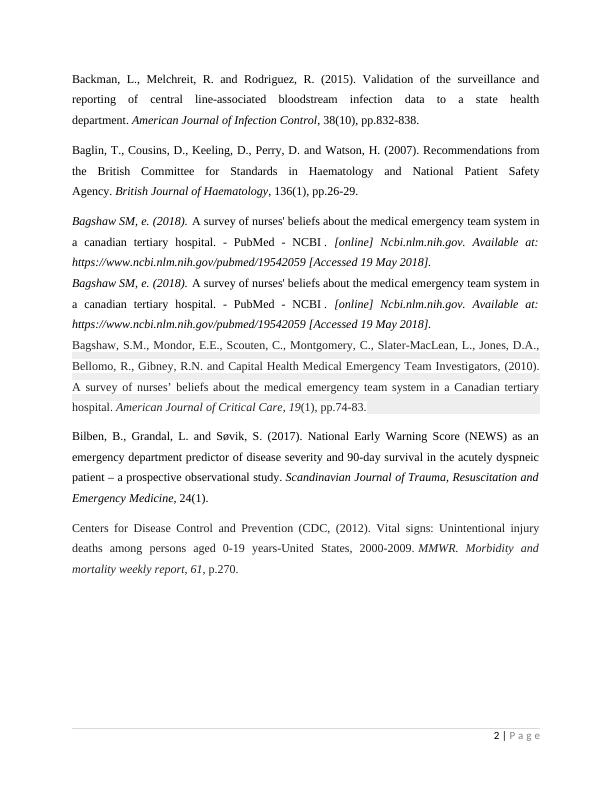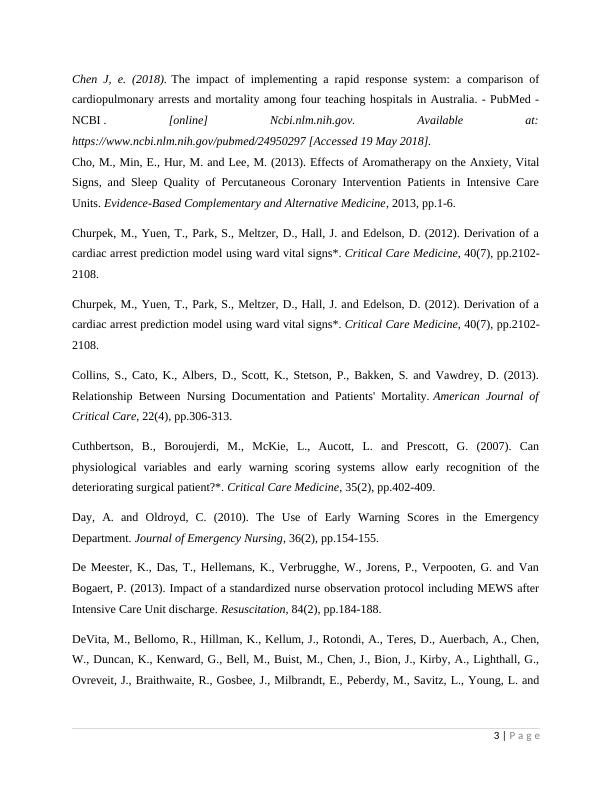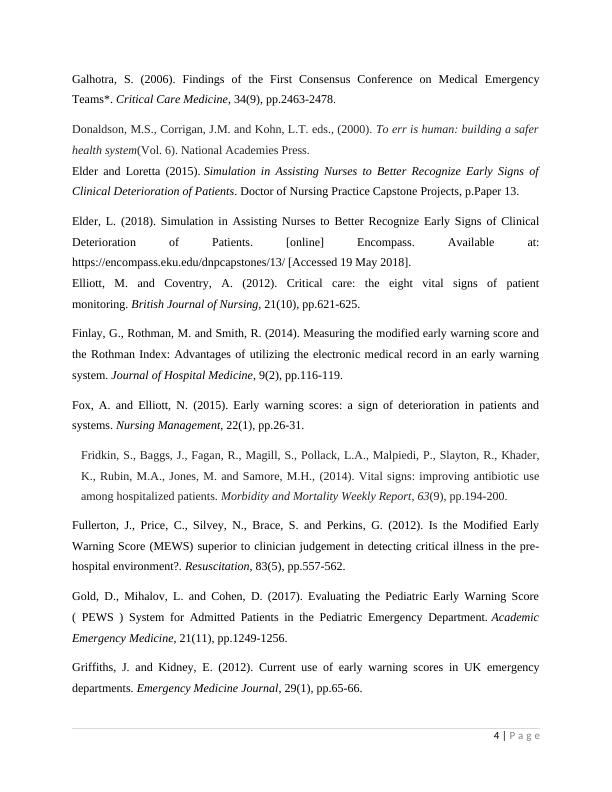The Importance of Early Warning Scores in Improving Patient Safety
Added on 2023-06-12
11 Pages4472 Words161 Views
References
Almutairi, K., Ahmad, M., Vinluan, J. and Almutairi, A. (2016). Random Cross-Sectional
Determination of the Level of Awareness Among Female Saudi Patients About Breast
Cancer. Journal of Cancer Education, 31(1), pp.131-135.
Al-Qahtani S, e. (2018). Impact of an intensivist-led multidisciplinary extended rapid response
team on hospital-wide cardiopulmonary arrests and mortality. - PubMed - NCBI . [online]
Ncbi.nlm.nih.gov. Available at: https://www.ncbi.nlm.nih.gov/pubmed/23263618 [Accessed 19
May 2018].
Al-Qahtani, S. and Al-Dorzi, H. (2010). Rapid response systems in acute hospital care. Annals of
Thoracic Medicine, 5(1), p.1.
AM, L. (2018). Rapid response teams: qualitative analysis of their effectiveness. - PubMed -
NCBI . [online] Ncbi.nlm.nih.gov. Available at:
https://www.ncbi.nlm.nih.gov/pubmed/23635929 [Accessed 19 May 2018].
AM, L. (2018). Rapid response teams: qualitative analysis of their effectiveness. - PubMed -
NCBI . [online] Ncbi.nlm.nih.gov. Available at:
https://www.ncbi.nlm.nih.gov/pubmed/23635929 [Accessed 19 May 2018].
Arabi, Y., Arifi, A., Balkhy, H., Najm, H., Aldawood, A., Ghabashi, A., Hawa, H., Alothman,
A., Khaldi, A. and Al Raiy, B. (2014). Clinical Course and Outcomes of Critically Ill Patients
With Middle East Respiratory Syndrome Coronavirus Infection. Annals of Internal Medicine,
160(6), pp.389-397.
1 | P a g e
Almutairi, K., Ahmad, M., Vinluan, J. and Almutairi, A. (2016). Random Cross-Sectional
Determination of the Level of Awareness Among Female Saudi Patients About Breast
Cancer. Journal of Cancer Education, 31(1), pp.131-135.
Al-Qahtani S, e. (2018). Impact of an intensivist-led multidisciplinary extended rapid response
team on hospital-wide cardiopulmonary arrests and mortality. - PubMed - NCBI . [online]
Ncbi.nlm.nih.gov. Available at: https://www.ncbi.nlm.nih.gov/pubmed/23263618 [Accessed 19
May 2018].
Al-Qahtani, S. and Al-Dorzi, H. (2010). Rapid response systems in acute hospital care. Annals of
Thoracic Medicine, 5(1), p.1.
AM, L. (2018). Rapid response teams: qualitative analysis of their effectiveness. - PubMed -
NCBI . [online] Ncbi.nlm.nih.gov. Available at:
https://www.ncbi.nlm.nih.gov/pubmed/23635929 [Accessed 19 May 2018].
AM, L. (2018). Rapid response teams: qualitative analysis of their effectiveness. - PubMed -
NCBI . [online] Ncbi.nlm.nih.gov. Available at:
https://www.ncbi.nlm.nih.gov/pubmed/23635929 [Accessed 19 May 2018].
Arabi, Y., Arifi, A., Balkhy, H., Najm, H., Aldawood, A., Ghabashi, A., Hawa, H., Alothman,
A., Khaldi, A. and Al Raiy, B. (2014). Clinical Course and Outcomes of Critically Ill Patients
With Middle East Respiratory Syndrome Coronavirus Infection. Annals of Internal Medicine,
160(6), pp.389-397.
1 | P a g e

Backman, L., Melchreit, R. and Rodriguez, R. (2015). Validation of the surveillance and
reporting of central line-associated bloodstream infection data to a state health
department. American Journal of Infection Control, 38(10), pp.832-838.
Baglin, T., Cousins, D., Keeling, D., Perry, D. and Watson, H. (2007). Recommendations from
the British Committee for Standards in Haematology and National Patient Safety
Agency. British Journal of Haematology, 136(1), pp.26-29.
Bagshaw SM, e. (2018). A survey of nurses' beliefs about the medical emergency team system in
a canadian tertiary hospital. - PubMed - NCBI . [online] Ncbi.nlm.nih.gov. Available at:
https://www.ncbi.nlm.nih.gov/pubmed/19542059 [Accessed 19 May 2018].
Bagshaw SM, e. (2018). A survey of nurses' beliefs about the medical emergency team system in
a canadian tertiary hospital. - PubMed - NCBI . [online] Ncbi.nlm.nih.gov. Available at:
https://www.ncbi.nlm.nih.gov/pubmed/19542059 [Accessed 19 May 2018].
Bagshaw, S.M., Mondor, E.E., Scouten, C., Montgomery, C., Slater-MacLean, L., Jones, D.A.,
Bellomo, R., Gibney, R.N. and Capital Health Medical Emergency Team Investigators, (2010).
A survey of nurses’ beliefs about the medical emergency team system in a Canadian tertiary
hospital. American Journal of Critical Care, 19(1), pp.74-83.
Bilben, B., Grandal, L. and Søvik, S. (2017). National Early Warning Score (NEWS) as an
emergency department predictor of disease severity and 90-day survival in the acutely dyspneic
patient – a prospective observational study. Scandinavian Journal of Trauma, Resuscitation and
Emergency Medicine, 24(1).
Centers for Disease Control and Prevention (CDC, (2012). Vital signs: Unintentional injury
deaths among persons aged 0-19 years-United States, 2000-2009. MMWR. Morbidity and
mortality weekly report, 61, p.270.
2 | P a g e
reporting of central line-associated bloodstream infection data to a state health
department. American Journal of Infection Control, 38(10), pp.832-838.
Baglin, T., Cousins, D., Keeling, D., Perry, D. and Watson, H. (2007). Recommendations from
the British Committee for Standards in Haematology and National Patient Safety
Agency. British Journal of Haematology, 136(1), pp.26-29.
Bagshaw SM, e. (2018). A survey of nurses' beliefs about the medical emergency team system in
a canadian tertiary hospital. - PubMed - NCBI . [online] Ncbi.nlm.nih.gov. Available at:
https://www.ncbi.nlm.nih.gov/pubmed/19542059 [Accessed 19 May 2018].
Bagshaw SM, e. (2018). A survey of nurses' beliefs about the medical emergency team system in
a canadian tertiary hospital. - PubMed - NCBI . [online] Ncbi.nlm.nih.gov. Available at:
https://www.ncbi.nlm.nih.gov/pubmed/19542059 [Accessed 19 May 2018].
Bagshaw, S.M., Mondor, E.E., Scouten, C., Montgomery, C., Slater-MacLean, L., Jones, D.A.,
Bellomo, R., Gibney, R.N. and Capital Health Medical Emergency Team Investigators, (2010).
A survey of nurses’ beliefs about the medical emergency team system in a Canadian tertiary
hospital. American Journal of Critical Care, 19(1), pp.74-83.
Bilben, B., Grandal, L. and Søvik, S. (2017). National Early Warning Score (NEWS) as an
emergency department predictor of disease severity and 90-day survival in the acutely dyspneic
patient – a prospective observational study. Scandinavian Journal of Trauma, Resuscitation and
Emergency Medicine, 24(1).
Centers for Disease Control and Prevention (CDC, (2012). Vital signs: Unintentional injury
deaths among persons aged 0-19 years-United States, 2000-2009. MMWR. Morbidity and
mortality weekly report, 61, p.270.
2 | P a g e

Chen J, e. (2018). The impact of implementing a rapid response system: a comparison of
cardiopulmonary arrests and mortality among four teaching hospitals in Australia. - PubMed -
NCBI . [online] Ncbi.nlm.nih.gov. Available at:
https://www.ncbi.nlm.nih.gov/pubmed/24950297 [Accessed 19 May 2018].
Cho, M., Min, E., Hur, M. and Lee, M. (2013). Effects of Aromatherapy on the Anxiety, Vital
Signs, and Sleep Quality of Percutaneous Coronary Intervention Patients in Intensive Care
Units. Evidence-Based Complementary and Alternative Medicine, 2013, pp.1-6.
Churpek, M., Yuen, T., Park, S., Meltzer, D., Hall, J. and Edelson, D. (2012). Derivation of a
cardiac arrest prediction model using ward vital signs*. Critical Care Medicine, 40(7), pp.2102-
2108.
Churpek, M., Yuen, T., Park, S., Meltzer, D., Hall, J. and Edelson, D. (2012). Derivation of a
cardiac arrest prediction model using ward vital signs*. Critical Care Medicine, 40(7), pp.2102-
2108.
Collins, S., Cato, K., Albers, D., Scott, K., Stetson, P., Bakken, S. and Vawdrey, D. (2013).
Relationship Between Nursing Documentation and Patients' Mortality. American Journal of
Critical Care, 22(4), pp.306-313.
Cuthbertson, B., Boroujerdi, M., McKie, L., Aucott, L. and Prescott, G. (2007). Can
physiological variables and early warning scoring systems allow early recognition of the
deteriorating surgical patient?*. Critical Care Medicine, 35(2), pp.402-409.
Day, A. and Oldroyd, C. (2010). The Use of Early Warning Scores in the Emergency
Department. Journal of Emergency Nursing, 36(2), pp.154-155.
De Meester, K., Das, T., Hellemans, K., Verbrugghe, W., Jorens, P., Verpooten, G. and Van
Bogaert, P. (2013). Impact of a standardized nurse observation protocol including MEWS after
Intensive Care Unit discharge. Resuscitation, 84(2), pp.184-188.
DeVita, M., Bellomo, R., Hillman, K., Kellum, J., Rotondi, A., Teres, D., Auerbach, A., Chen,
W., Duncan, K., Kenward, G., Bell, M., Buist, M., Chen, J., Bion, J., Kirby, A., Lighthall, G.,
Ovreveit, J., Braithwaite, R., Gosbee, J., Milbrandt, E., Peberdy, M., Savitz, L., Young, L. and
3 | P a g e
cardiopulmonary arrests and mortality among four teaching hospitals in Australia. - PubMed -
NCBI . [online] Ncbi.nlm.nih.gov. Available at:
https://www.ncbi.nlm.nih.gov/pubmed/24950297 [Accessed 19 May 2018].
Cho, M., Min, E., Hur, M. and Lee, M. (2013). Effects of Aromatherapy on the Anxiety, Vital
Signs, and Sleep Quality of Percutaneous Coronary Intervention Patients in Intensive Care
Units. Evidence-Based Complementary and Alternative Medicine, 2013, pp.1-6.
Churpek, M., Yuen, T., Park, S., Meltzer, D., Hall, J. and Edelson, D. (2012). Derivation of a
cardiac arrest prediction model using ward vital signs*. Critical Care Medicine, 40(7), pp.2102-
2108.
Churpek, M., Yuen, T., Park, S., Meltzer, D., Hall, J. and Edelson, D. (2012). Derivation of a
cardiac arrest prediction model using ward vital signs*. Critical Care Medicine, 40(7), pp.2102-
2108.
Collins, S., Cato, K., Albers, D., Scott, K., Stetson, P., Bakken, S. and Vawdrey, D. (2013).
Relationship Between Nursing Documentation and Patients' Mortality. American Journal of
Critical Care, 22(4), pp.306-313.
Cuthbertson, B., Boroujerdi, M., McKie, L., Aucott, L. and Prescott, G. (2007). Can
physiological variables and early warning scoring systems allow early recognition of the
deteriorating surgical patient?*. Critical Care Medicine, 35(2), pp.402-409.
Day, A. and Oldroyd, C. (2010). The Use of Early Warning Scores in the Emergency
Department. Journal of Emergency Nursing, 36(2), pp.154-155.
De Meester, K., Das, T., Hellemans, K., Verbrugghe, W., Jorens, P., Verpooten, G. and Van
Bogaert, P. (2013). Impact of a standardized nurse observation protocol including MEWS after
Intensive Care Unit discharge. Resuscitation, 84(2), pp.184-188.
DeVita, M., Bellomo, R., Hillman, K., Kellum, J., Rotondi, A., Teres, D., Auerbach, A., Chen,
W., Duncan, K., Kenward, G., Bell, M., Buist, M., Chen, J., Bion, J., Kirby, A., Lighthall, G.,
Ovreveit, J., Braithwaite, R., Gosbee, J., Milbrandt, E., Peberdy, M., Savitz, L., Young, L. and
3 | P a g e

Galhotra, S. (2006). Findings of the First Consensus Conference on Medical Emergency
Teams*. Critical Care Medicine, 34(9), pp.2463-2478.
Donaldson, M.S., Corrigan, J.M. and Kohn, L.T. eds., (2000). To err is human: building a safer
health system(Vol. 6). National Academies Press.
Elder and Loretta (2015). Simulation in Assisting Nurses to Better Recognize Early Signs of
Clinical Deterioration of Patients. Doctor of Nursing Practice Capstone Projects, p.Paper 13.
Elder, L. (2018). Simulation in Assisting Nurses to Better Recognize Early Signs of Clinical
Deterioration of Patients. [online] Encompass. Available at:
https://encompass.eku.edu/dnpcapstones/13/ [Accessed 19 May 2018].
Elliott, M. and Coventry, A. (2012). Critical care: the eight vital signs of patient
monitoring. British Journal of Nursing, 21(10), pp.621-625.
Finlay, G., Rothman, M. and Smith, R. (2014). Measuring the modified early warning score and
the Rothman Index: Advantages of utilizing the electronic medical record in an early warning
system. Journal of Hospital Medicine, 9(2), pp.116-119.
Fox, A. and Elliott, N. (2015). Early warning scores: a sign of deterioration in patients and
systems. Nursing Management, 22(1), pp.26-31.
Fridkin, S., Baggs, J., Fagan, R., Magill, S., Pollack, L.A., Malpiedi, P., Slayton, R., Khader,
K., Rubin, M.A., Jones, M. and Samore, M.H., (2014). Vital signs: improving antibiotic use
among hospitalized patients. Morbidity and Mortality Weekly Report, 63(9), pp.194-200.
Fullerton, J., Price, C., Silvey, N., Brace, S. and Perkins, G. (2012). Is the Modified Early
Warning Score (MEWS) superior to clinician judgement in detecting critical illness in the pre-
hospital environment?. Resuscitation, 83(5), pp.557-562.
Gold, D., Mihalov, L. and Cohen, D. (2017). Evaluating the Pediatric Early Warning Score
( PEWS ) System for Admitted Patients in the Pediatric Emergency Department. Academic
Emergency Medicine, 21(11), pp.1249-1256.
Griffiths, J. and Kidney, E. (2012). Current use of early warning scores in UK emergency
departments. Emergency Medicine Journal, 29(1), pp.65-66.
4 | P a g e
Teams*. Critical Care Medicine, 34(9), pp.2463-2478.
Donaldson, M.S., Corrigan, J.M. and Kohn, L.T. eds., (2000). To err is human: building a safer
health system(Vol. 6). National Academies Press.
Elder and Loretta (2015). Simulation in Assisting Nurses to Better Recognize Early Signs of
Clinical Deterioration of Patients. Doctor of Nursing Practice Capstone Projects, p.Paper 13.
Elder, L. (2018). Simulation in Assisting Nurses to Better Recognize Early Signs of Clinical
Deterioration of Patients. [online] Encompass. Available at:
https://encompass.eku.edu/dnpcapstones/13/ [Accessed 19 May 2018].
Elliott, M. and Coventry, A. (2012). Critical care: the eight vital signs of patient
monitoring. British Journal of Nursing, 21(10), pp.621-625.
Finlay, G., Rothman, M. and Smith, R. (2014). Measuring the modified early warning score and
the Rothman Index: Advantages of utilizing the electronic medical record in an early warning
system. Journal of Hospital Medicine, 9(2), pp.116-119.
Fox, A. and Elliott, N. (2015). Early warning scores: a sign of deterioration in patients and
systems. Nursing Management, 22(1), pp.26-31.
Fridkin, S., Baggs, J., Fagan, R., Magill, S., Pollack, L.A., Malpiedi, P., Slayton, R., Khader,
K., Rubin, M.A., Jones, M. and Samore, M.H., (2014). Vital signs: improving antibiotic use
among hospitalized patients. Morbidity and Mortality Weekly Report, 63(9), pp.194-200.
Fullerton, J., Price, C., Silvey, N., Brace, S. and Perkins, G. (2012). Is the Modified Early
Warning Score (MEWS) superior to clinician judgement in detecting critical illness in the pre-
hospital environment?. Resuscitation, 83(5), pp.557-562.
Gold, D., Mihalov, L. and Cohen, D. (2017). Evaluating the Pediatric Early Warning Score
( PEWS ) System for Admitted Patients in the Pediatric Emergency Department. Academic
Emergency Medicine, 21(11), pp.1249-1256.
Griffiths, J. and Kidney, E. (2012). Current use of early warning scores in UK emergency
departments. Emergency Medicine Journal, 29(1), pp.65-66.
4 | P a g e

End of preview
Want to access all the pages? Upload your documents or become a member.
Related Documents
Advocacy and Global Healthlg...
|3
|587
|500
